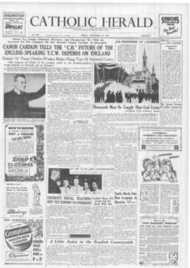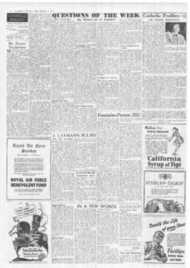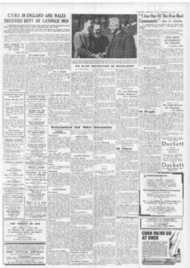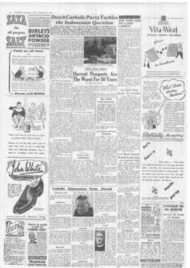Page 4, 13th September 1946
Page 4

Report an error
Noticed an error on this page?If you've noticed an error in this article please click here to report it.
Tags
Share
Related articles
Sir Frank Brangwyn Dies
The Exuberance Of Frank Brangwyn
Bran Gwyn, A Man Of Big Faith
Art
25 Years Ag
I Catholic Profiles : 701
SIR FRANK BRANGWYN
HAVING regard to his future work as an artist, Frank Brangwyn started life under what might well have proved fatal circumstances. His father was an architect living, at the time Frank was born, that is, in 1867, in the
old city o f Bruges. Curtis 13rangwyn was interested in all forms of ecclesiastical art and was an exporient of the Gothic Revival. His son was little more than a boy when he became an assistant to William Morris. Under these two powerful influences his originality might have been stifled. Instead of the robust personality and the creative genius be the men who presided over his early years had a practical bent which linked thanishe might achtilehapvtemilbecoofmaen no more and utopian cult. Fortunately both li their art with industry, and. no less fortunately, he was not made of the stuff out of which docile pupils are fashioned. What he did was characteristic. He has a great respect for untutored genius. Bohemian and 'arty" circles have little attraction for him, And be is democratic in the best sense of that much maltreated word. " The difference between the ancestry of a duke and that of a dustman," he has been heard to say, " is that the duke keeps a record." And. he had in those days and still has a quite passionate admiration for the honest worker in any sphere, sailor, ploughman, tinker, factory-hand, collier or decorative craftsman making things for common roe. It was this liking for men in touch with actual life that dictated the step by which he escaped front the Gothic Revival and the Earthly Paradise in Morris' studio. He went to Sandwich, a small and ancient seaport on the Kent coast, to Jive among tisherfolls. With only a few pounds in his pocket, he established himself at the "Admiral Owen." It is on record that he " got on well " with his neighbours, painted the vessels in which they sailed, satisfying their professional eye for technical accuracy. and won their genuine friendship. Later, he shared their labours for awhile. shipping before the mast in the Garibaldi. a coastal barge. Most of his pictures in the next few years dealt with the sea.
IT must not be supposed, of course. that he despised the training he had received in his father's workshop and during his applenticeship to William Morris. Original genius does not ignore its masters; its business is to master its masters, using in its own way the lessons they have taught. But from henceforth he was free of cults and movements, free to develop his native genius according to his own conception of art. There are critics whet do not agree with that conception or approve of the work to which it has given birth. But to-day, at the age of 79, be can look back on a career of mounting professional success and on honours won of diverse kinds.
England has given him a Knighthood. Wales (he has Welsh blood in his veins) has elected hint an hots. LL.D. The French have made him Meier evith Cross of the Legion of Honour, as well as making hint a member of the Institute de France. The Italians have conferred on him the title of Commander with Cross of the Order of St. Maurice and St. Lazarus and made him Chevalier of the Order of the Crown of Italy. It is reckoned that between the.ns the various countries of Europe and the Americas have signalled hint out for some 511 such awards.
It has been a long life covering a period during which the world has changed almost beyond recognition. How has the man who started in Victorian studios faced those changes? Has he become a querulous critic of the modern age? It is difficult to think of Brangwyn as querulous; he is too sane, too robust and too courageous for that. He would rather that machinery had not come at all but since it has come he makes what he can of its good points. It is the artist's business, he would say, not to avoid ugliness but to conquer it, not to run away from the actual world but bend it to his purpose.
THE success which has rewarded him hits not spoilt him. His greatness is apparent in nothing so much as in his simplicity. He has his aversions— dilettanti, snobs and humbugs—but one notices in his conversation more than these his wide charity. The man who bee enriched the world by works displaying a rare opulence of colour and splendour of design is still the same a$ he who more than hall-a-century ago shipped before the mast in the coastal barge. Garibaldi.
Greatly as he loves his craft, he is not its slave. Big as is the artist, the (Continued on page 5)
blog comments powered by Disqus







